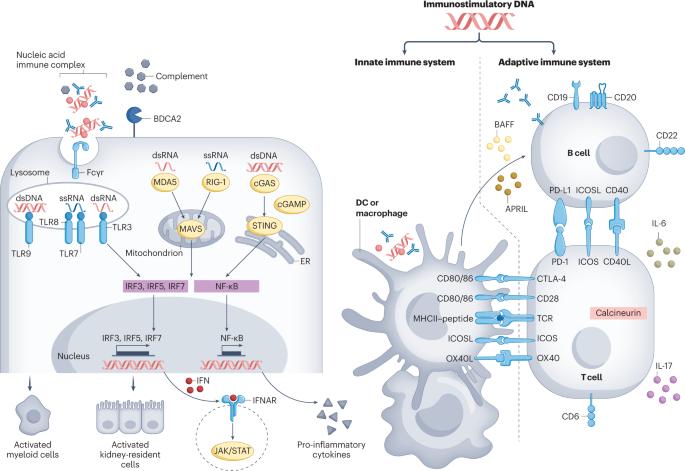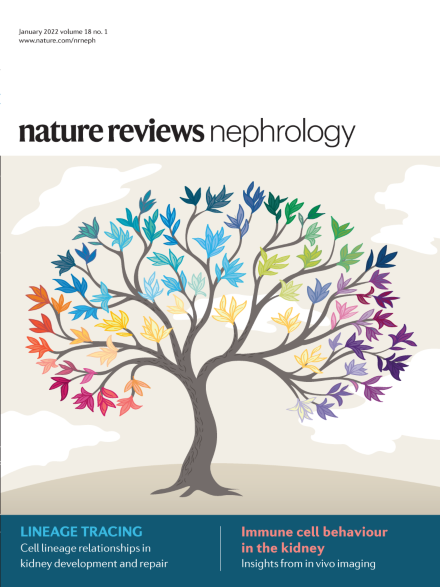Pathogenic cellular and molecular mediators in lupus nephritis
IF 39.8
1区 医学
Q1 UROLOGY & NEPHROLOGY
引用次数: 0
Abstract
Kidney involvement in patients with systemic lupus erythematosus — lupus nephritis (LN) — is one of the most important and common clinical manifestations of this disease and occurs in 40–60% of patients. Current treatment regimens achieve a complete kidney response in only a minority of affected individuals, and 10–15% of patients with LN develop kidney failure, with its attendant morbidity and considerable prognostic implications. Moreover, the medications most often used to treat LN — corticosteroids in combination with immunosuppressive or cytotoxic drugs — are associated with substantial side effects. Advances in proteomics, flow cytometry and RNA sequencing have led to important new insights into immune cells, molecules and mechanistic pathways that are instrumental in the pathogenesis of LN. These insights, together with a renewed focus on the study of human LN kidney tissue, suggest new therapeutic targets that are already being tested in lupus animal models and early-phase clinical trials and, as such, are hoped to eventually lead to meaningful improvements in the care of patients with systemic lupus erythematosus-associated kidney disease. This Review examines the contribution of innate and adaptive immune cells to the pathogenesis of lupus nephritis, including new insights into the molecular mechanisms that drive this disease, such as recognition of endogenous chromatin by endosomal and cytosolic nucleic acid sensors.

狼疮性肾炎的致病细胞和分子介质
系统性红斑狼疮患者的肾脏受累--狼疮性肾炎(LN)--是这种疾病最重要和最常见的临床表现之一,40%-60%的患者会出现这种情况。目前的治疗方案仅能使少数患者的肾脏获得完全反应,10%-15%的狼疮肾炎患者会出现肾衰竭,随之而来的是发病率和对预后的严重影响。此外,最常用于治疗 LN 的药物--皮质类固醇与免疫抑制剂或细胞毒药物--都有很大的副作用。蛋白质组学、流式细胞仪和 RNA 测序技术的进步使人们对 LN 发病机制中的免疫细胞、分子和机制途径有了新的认识。这些见解以及对人类 LN 肾组织研究的重新关注,提出了新的治疗靶点,这些靶点已在狼疮动物模型和早期临床试验中进行测试,因此有望最终为系统性红斑狼疮相关肾病患者的治疗带来有意义的改善。这篇综述探讨了先天性免疫细胞和适应性免疫细胞对狼疮肾炎发病机制的贡献,包括对驱动这种疾病的分子机制的新认识,如内质体和细胞膜核酸传感器对内源性染色质的识别。
本文章由计算机程序翻译,如有差异,请以英文原文为准。
求助全文
约1分钟内获得全文
求助全文
来源期刊

Nature Reviews Nephrology
医学-泌尿学与肾脏学
CiteScore
39.00
自引率
1.20%
发文量
127
审稿时长
6-12 weeks
期刊介绍:
Nature Reviews Nephrology aims to be the premier source of reviews and commentaries for the scientific communities it serves.
It strives to publish authoritative, accessible articles.
Articles are enhanced with clearly understandable figures, tables, and other display items.
Nature Reviews Nephrology publishes Research Highlights, News & Views, Comments, Reviews, Perspectives, and Consensus Statements.
The content is relevant to nephrologists and basic science researchers.
The broad scope of the journal ensures that the work reaches the widest possible audience.
 求助内容:
求助内容: 应助结果提醒方式:
应助结果提醒方式:


